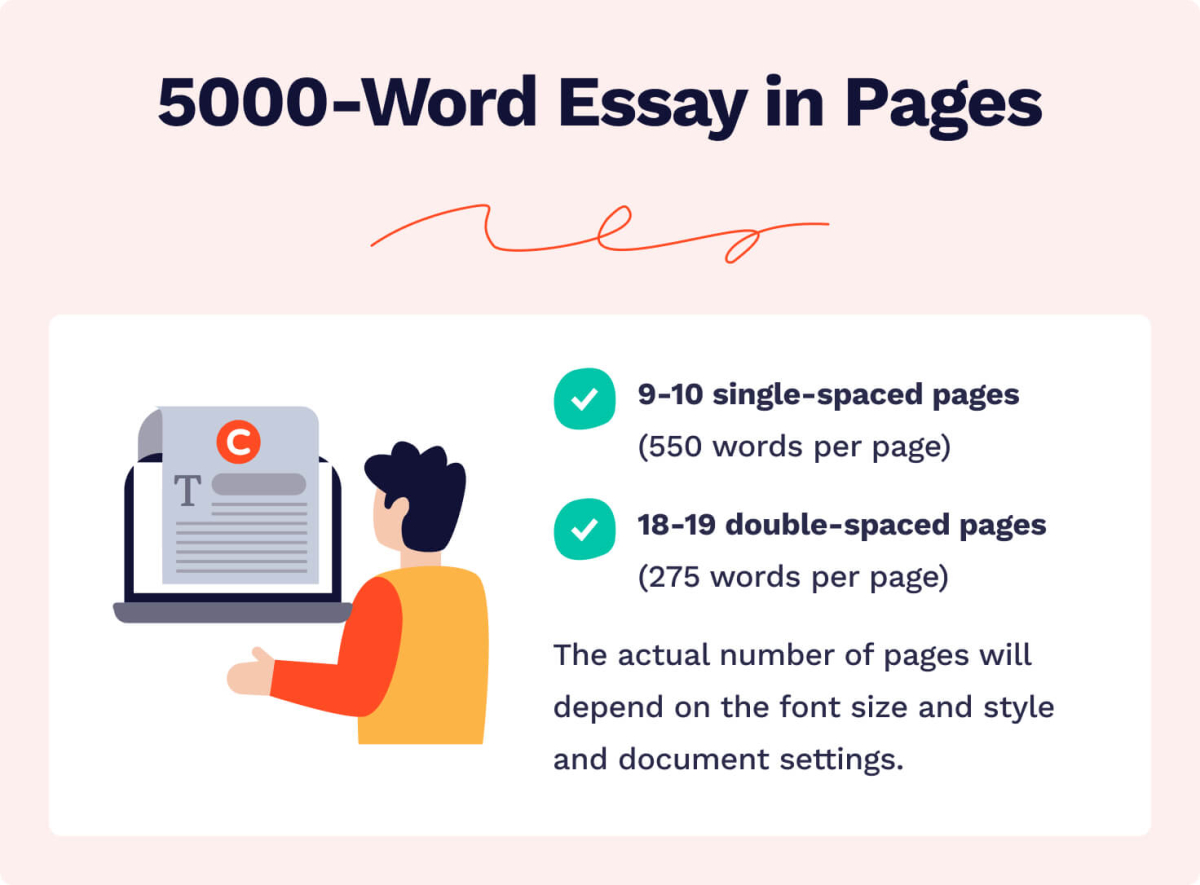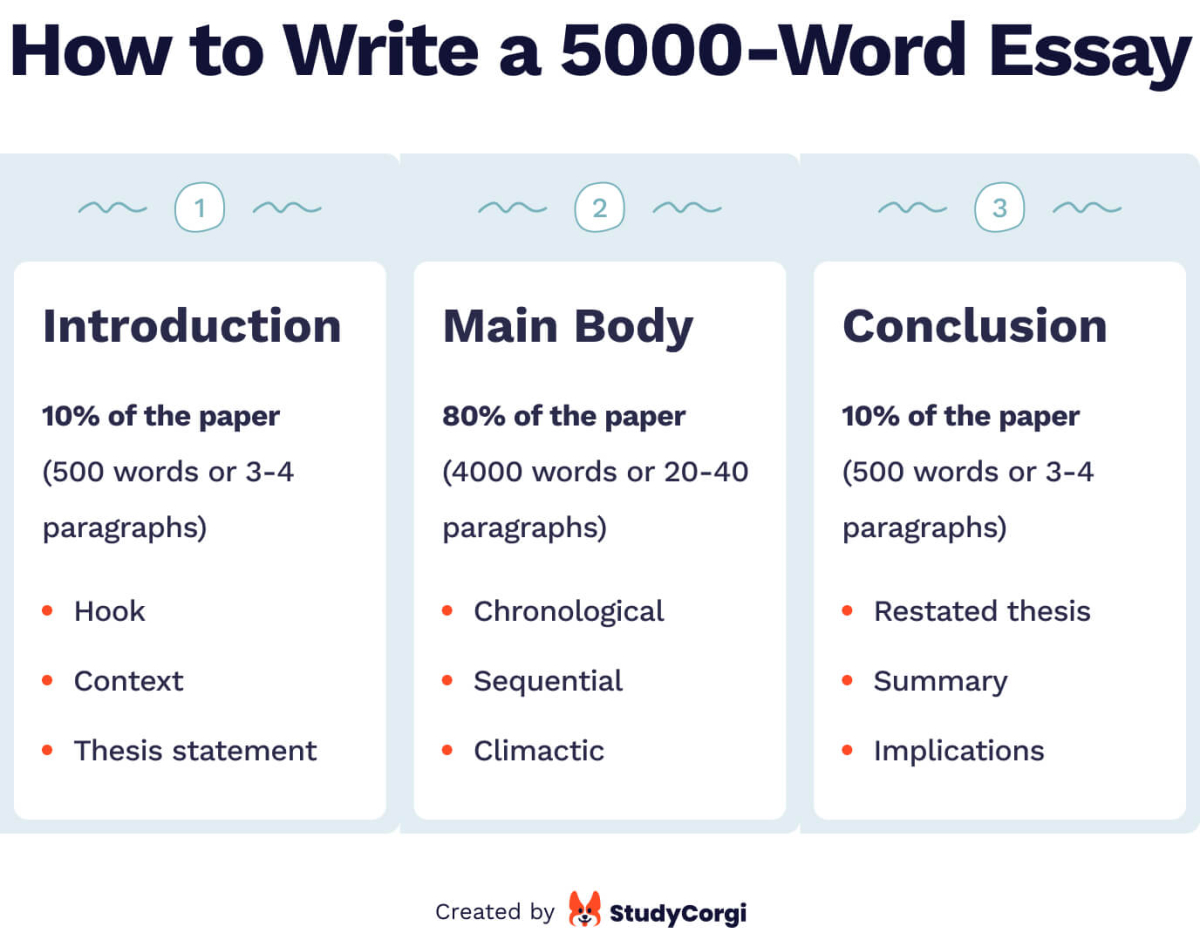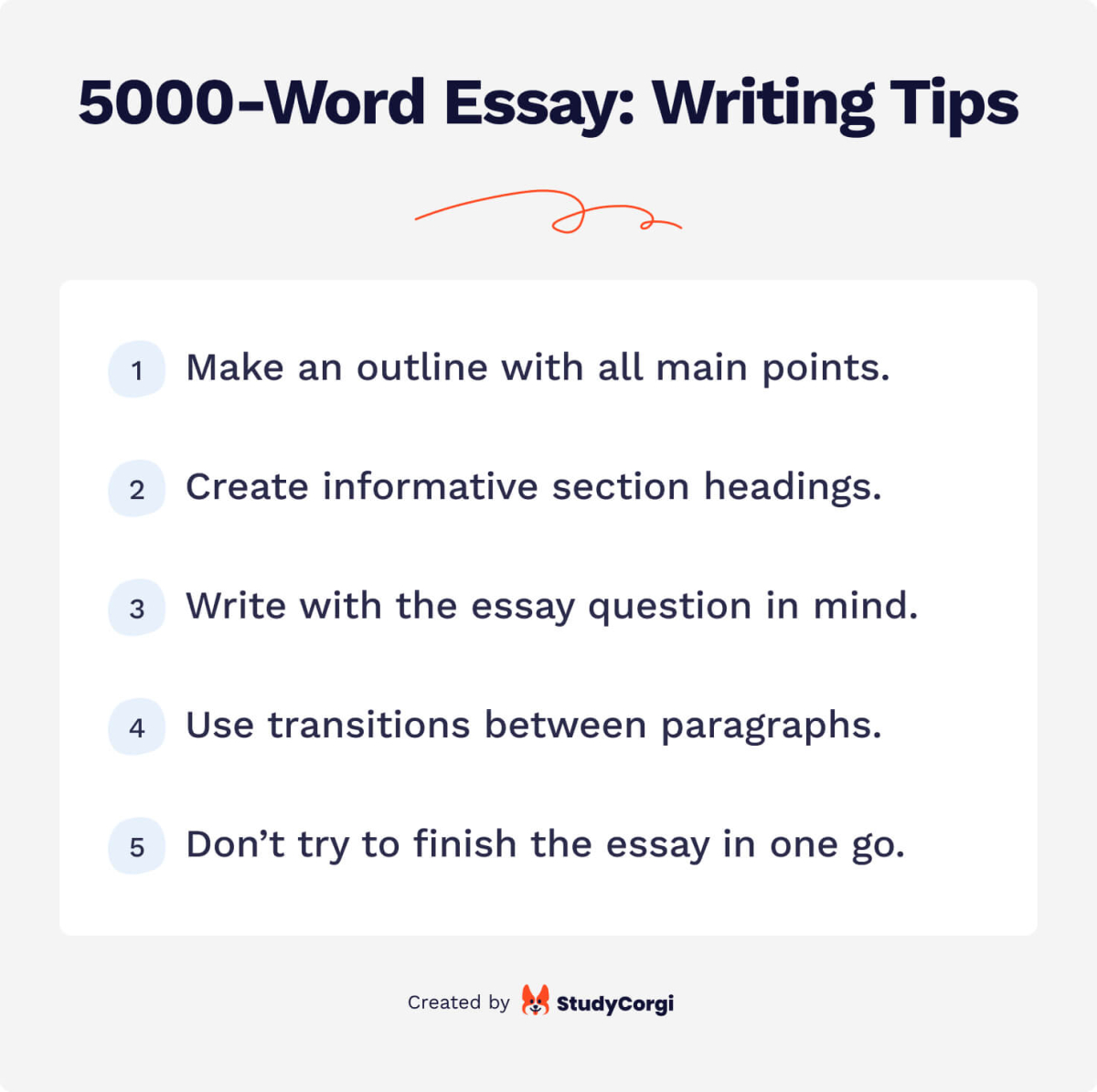If you know how to write a 5000-word essay, you can tackle any assignment. Whether it’s a research paper, thesis, coursework, or capstone project, understanding the scope and requirements of such a task is fundamental. With a clear plan and proper content organization you will successfully complete the work.
The first question is, how many paragraphs is 5000 words? It varies, but a typical essay of this length may consist of around 40-50 paragraphs, depending on the volume and complexity of each section.
Following a standard 5000-word essay structure, the paper should have at least:
- An introduction (500-700 words),
- Body paragraphs divided into coherent sections (3500-4000 words),
- A strong conclusion (500-700 words).
In this guide, you will find a breakdown of the essential 5000-word essay rules, including tips on outlining, time management, and developing arguments. While we can’t guarantee that, by following these recommendations, you’ll be able to write a 5000-word essay in one night, we promise that you’ll gain a clear understanding of how to arrange and highlight your ideas effectively.
📝 What Does a 5000 Word Essay Look Like?
Let’s look at the structure of an essay and its body paragraphs to give you a general idea of what a 5000-word essay looks like.
5000 Word Essay Structure
A 5000-words essay structure is similar to that of shorter papers. Yet, due to the large number of words, such writings should be carefully organized using headings and subheadings. Besides, this word count implies a thorough examination of the subject, so you may need appendices to include additional information.
Here are the main elements of a 5000-word essay.
- Title page. A title page* should include the essay’s title, your name, educational institution, course information, instructor’s name, and due date.
- Abstract. An abstract* summarizes a paper in 150-250 words. It includes the writing purpose, problem statement, methodology, results, and conclusions.
- Table of contents. A table of contents* guides readers around your paper. It lists all headings and subheadings with their respective page numbers.
- Introduction. An introduction captures the readers’ attention, provides relevant background information, and outlines the direction of the essay with a thesis statement.
- Main body. Body paragraphs elaborate on the essay’s topic or argument. They include a topic sentence, supporting evidence, and a concluding sentence.
- Conclusion. A conclusion provides closure for readers and reminds them of the paper’s contents and value.
- Reference list. A reference list contains publication data for the sources cited in your article. Each entry has all the information your readers need to find your sources.
- Appendices. An appendix* comprises non-essential but helpful information on the topic. Supplemental tables, figures, maps, and raw data are usually included in appendices.
The sign (*) marks optional elements that may or may not be included based on your assignment instructions.
5000 Words Paragraph
With a paragraph length of 100-200 words, an essay in 5000 words may have 26-48 paragraphs:
- 3-4 for the introduction;
- 20-40 for the main body;
- 3-4 for the conclusion.
A compelling body paragraph clarifies, proves, and supports your thesis statement. Here are the main elements of an effective paragraph:
- A topic sentence. Begin by summarizing the central idea of a paragraph to direct the reader through your argument. Ensure your topic sentence is connected to your thesis.
- An explanation of the topic sentence. If your topic sentence needs some explication, add 1-2 sentences to clarify it.
- Evidence. Integrate your evidence (facts, quotes, statistics, etc.) in the text smoothly. Don’t just drop in the quotation without introducing its author and tying it to your argument.
- An explanation of the evidence. First, unpack your proof to show you understand its meaning. Then, demonstrate how this evidence supports your topic sentence or thesis statement.
- Concluding sentence. Finish with a closing statement that explains how this paragraph contributes to the overall development of your argument.
Look at a 5000-words paragraph example taken from an essay “Alternative Fuel Sources in Aviation” to see how these elements work in practice:
[Topic sentence] Replacing aviation kerosene with biodiesel has the highest potential to achieve reductions in aviation carbon dioxide emissions. [Explanation] This is important because this fuel type can be used in existing aircraft. It can be added to tanks and mixed with jet fuel or kerosene. [Evidence] Kim et al. (2019, p. 317) report that “due to high R&D costs and long lifecycle of aircraft, drop-in biofuels stand as a promising solution for addressing aviation’s environmental sustainability.” [Explanation] There is already a proven safe technology that gives effective results. The difficulty today lies in the fact that only a few plants produce bio-aviation fuel, while more than a hundred new processing plants are needed every year. [Concluding sentence] So, the industry is yet quite far from the figures for the required number of deliveries.
📃 5000 Word Essay in Pages
The number of pages that take up 5000 words depends on the font and document settings. Let’s dive in and learn how many pages a 5000-word essay is with different formatting options!

5000 Words Single-Spaced
The page count of a 5000-word research paper depends on the font size, margins, etc. If we choose the 12-point Times New Roman font, set single spacing, and 1-inch margins, then 1 page will be approximately 550 words. As a result, 5000 words with such parameters will take about 9 single-spaced pages.
5000 Words Double-Spaced
The most commonly used settings for academic essays are double spacing, the 12-point Times New Roman or Arial font, and 1-inch margins on all sides. With these parameters, 1 page will take 275 words on average. Accordingly, a 5000-word essay will take slightly more than 18 double-spaced pages.
✍️ How to Write a 5000 Word Essay
Have you ever struggled with structuring your writing? Then we have something for you! Let’s look at how to write each part of a 5000-word essay.

Introduction
An introduction grabs readers’ attention, provides the context of the topic, and presents the essay’s purpose and direction. It often begins with an outline of the basic concepts of the subject and then gives specific ideas that will be explored in the body.
Here are some crucial components of the introductory paragraph:
- Hook. The hook is an opening statement that helps make a strong first impression. You can use quotes, anecdotes, facts, etc., to drive your readers in.
- Background information. Background information establishes a general backdrop for the paper by informing readers of everything they need to know before reading the essay’s body. It should start with broad thoughts and then narrow to one precise, focused idea.
- Thesis statement. The thesis statement should reveal the author’s motivation for writing, express the core idea of the essay, and provide a direction for the main body.
A 5000-word essay introduction takes 10% of the total word count, that is, 500 words. Since one paragraph usually contains 100-200 words, an introduction can take 3-4 paragraphs.
Main Body
The main body of a 5000-word essay contains 20-40 well-developed paragraphs. We have already discussed their structure above. Now, let’s look at how to organize this large number of paragraphs in a logical sequence!
1. Chronological Order.
Chronological order is typical for expository writing, which describes, presents, informs, or explains processes. It is also suitable for narrative essays that tell a story.
When employing this pattern, arrange the ideas in the order in which they occurred.
For example:
- first in time → last in time
- year 1895 → year 1920 → year 1945
2. Sequential Order.
A sequential organizational pattern suits many essay types, such as cause and effect, problem and solution, or compare and contrast.
When using this pattern, organize information in a step-by-step sequence to cover a particular process or event thoroughly.
For example:
- cause 1 → cause 2 → effect 1 → effect 2
- 1st difference → 2nd difference → 3rd difference
3. Climactic Order.
Climactic order is the order of importance. It is the most suitable for persuasive and argumentative essays.
In this pattern, you put the most significant ideas at the end of the paper.
For example:
- least important → most important
- general → specific
- most familiar → least familiar
Conclusion
A conclusion does not just restate your arguments or your research problem but also synthesizes your essential ideas.
A solid conclusion should do the following:
- Restate your argument. It is crucial to reiterate the paper’s thesis to remind readers of your claims at the beginning of the essay.
- Summarize your main points. An effective conclusion will connect the central ideas and relate them to one another.
- Clarify the context of your argument. Ensure that your readers understand the broader implications of your topic.
Like the introduction, the conclusion takes 10% of the word count — about 500 words — and can be divided into 3-4 paragraphs.
How Long Does It Take to Write a 5000 Word Essay?
Depending on your typing speed, it takes 100 to 200 minutes to type 5000 words on a keyboard. However, an academic paper also requires much time for researching, outlining, writing, and proofreading. As a result, you may spend from 2-5 hours to several days on a 5000-word essay.
How Many References for a 5000 Word Essay?
A rule of thumb is to have 1 source for each page assigned. So, a 20-page paper containing 5000 words will require around 20-30 references. Each paragraph will typically have 2–3 citations. Remember that no source should appear only once in your paper or be cited so frequently that it seems you only have one.
✔️ 5000 Words Essay: Bonus Writing Tips
We know how to make the writing process smoother and more manageable! Check out the tips below and use them while drafting your 5000-word essay:
- Create an outline. Outlining will help you organize ideas logically and thoughtfully and plan the use of sources to support your main points.
- Make informative section headings. Organize the body into sections with well-worded headings that represent the topic discussed.
- Keep the essay question in mind. If you have been given an assignment question, always bear it in mind while writing your essay to ensure you don’t stray from the subject.
- Use links between paragraphs. Make logical transitions between paragraphs to increase the readability and coherence of your writing.
- Take breaks. Don’t try to write your paper in one day or night. It is okay to take breaks and compose it over several days.

📋 5000 Word Essay Example
We suggest you check out a 5000-words example entitled “Importance of Checklists in Veterinary Practice.” Here, we’ll examine the structure of this paper.
1. Introduction. The introduction of this example is divided into 3 paragraphs and includes 3 elements:
- Hook. From the first sentence, we understand that the essay is concerned with animal care.
- Background information. The essay introduces the problem of mistakes in veterinary practice.
- Thesis statement. The paper emphasizes the importance of checklists in veterinary medicine as a solution to the issue.
2. Main body. The main body is divided into 5 sections with informative subheadings:
- Importance of checklists and their impact on patient safety within veterinary hospitals.
- Common mistakes within the veterinary profession.
- Patient safety and its significance within the veterinary practice.
- Challenges facing veterinary medicine and practice.
- How changing technology is helping veterinary medicine and practice.
The author used a sequential organizational pattern since the paragraphs are arranged by topics.
3. Conclusion. The conclusion consists of 3 paragraphs, like the introduction. It summarizes all the key points the author has indicated in the main body and highlights the importance of checklists in veterinary practice.
4. Reference list. There are 60 sources mentioned on the reference list, which is more than enough for an essay of 5000 words. Unless your professor instructs otherwise, you should aim at 1 source per page. So, a 5000-word article can contain up to 20 references.
📚 5000 Word Essay Topics
- Alcohol use during pregnancy and a child’s behavioral disorders.
- Comparing the relations of church and state in Europe.
- Applications of cloud technologies in bioinformatics.
- Copyright infringement and artificial neural networks.
- The perception of male beauty in the English-speaking world.
- Causes and effects of rising cybercrime rates during COVID-19.
- Doomsday scenarios in different cultures and their importance.
- Extremism on social media: Sentiment analysis of textual evidence.
- Mandatory recycling: Is it a feasible solution to environmental issues?
- The impact of homeschooling on socio-emotional development.
